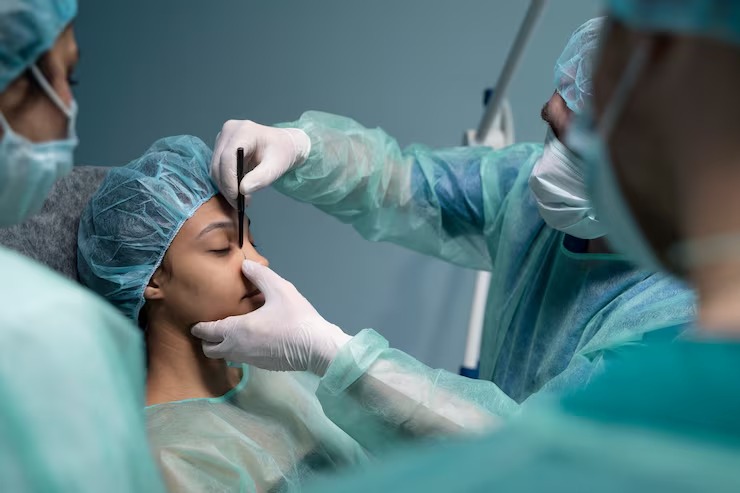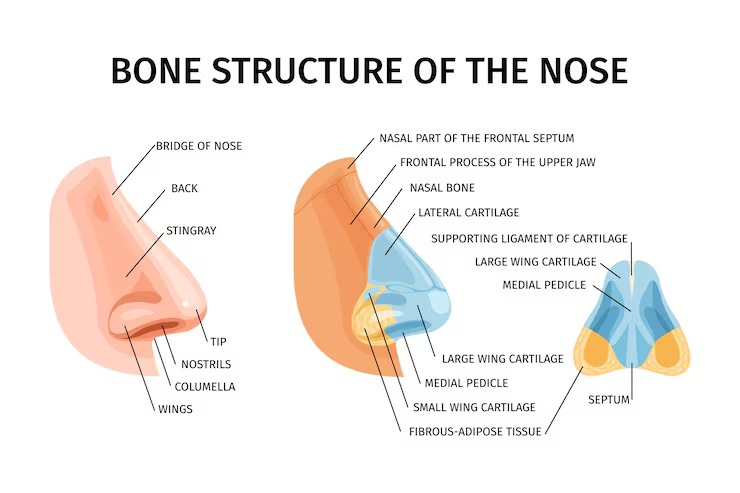
Select City
Septoplasty improves breathing and provides relief from sinus infections. The procedure corrects the deviated nasal septum. At Pristyn Care, we offer an advanced septoplasty procedure with top ENT specialists.
Septoplasty improves breathing and provides relief from sinus infections. The procedure corrects the ... Read More




Free Consultation

Free Cab Facility

No-Cost EMI

Support in Insurance Claim

1-day Hospitalization

USFDA-Approved Procedure
Choose Your City
It help us to find the best doctors near you.
Bangalore
Chennai
Delhi
Hyderabad
Kochi
Mumbai
Pune
Delhi
Hyderabad
Pune
Mumbai
Bangalore
The nasal septum is made up of cartilage and bone. It divides the nasal cavity into two nostrils. A deviated nasal septum can block airflow. It can cause breathing problems and infections. Septoplasty straightens the nasal septum to restore airflow.

The procedure is done in a hospital or surgical centre. An ENT surgeon performs it under local or general anaesthesia. ENT specialists suggest septoplasty alone or combined with other nasal surgeries.
• Disease name
Deviated Nasal Septum
• Surgery name
Septoplasty
• Duration
1 - 2 hours
• Treated by
ENT Surgeons (Otolaryngologists)

Fill details to get actual cost
A severely deviated nasal septum can affect breathing. It reduces the quality of life. Common symptoms of a deviated nasal septum include:
A deviated septum may occur due to several reasons, including:

Nose deviation requires septoplasty if it impacts sinus health.
Endoscopy or a CT scan can diagnose a deviated septum. Septoplasty provides lasting correction of a deviated septum. Success rates range from 43–85%. Septoplasty is done in severe cases affecting the quality of life.
Diet & Lifestyle Consultation
Post-Surgery Free Follow-Up
Free Cab Facility

24*7 Patient Support
Septoplasty uses local or general anaesthesia. The choice depends on comfort, deviation, and the surgeon’s preference. The surgery is intranasal. It leaves no external incisions or visible scars.
Steps Involved in Septoplasty Surgery:
Anaesthesia ensures comfort and reduces pain during surgery. Minor corrections use local anaesthesia. Major procedures require general anaesthesia.
A small incision is made on one side of the nasal septum. It helps to access the cartilage and bone.
The surgeon lifts the septum’s protective lining. It helps to expose the deviated portions.
The surgeon reshapes or repositions the deviated cartilage & bone. They may partially remove some to straighten the septum.
The mucosal flap is placed back over the corrected septum.
Internal splints or soft nasal packing support healing and prevent septal hematoma. The entire septoplasty surgery takes 30 to 90 minutes. Most patients get same-day discharge.

The entire septoplasty surgery takes 30 to 90 minutes. Most patients get same-day discharge unless complications require overnight observation.
It is performed through intranasal incisions.
Minimally invasive method using an endoscope. It improves visualisation.
It uses external incisions for complex deviations. The surgeon makes an incision inside the nostril to access the septum.
Laser-assisted Septoplasty
Sometimes used to soften cartilage; limited to select cases.
Endoscopic septoplasty improves visualisation and precision. It reduces problems in complex cases. The ENT specialist decides the best approach before surgery.
The procedure improves the physiological functioning of the nose. The advantages include:
These results appear after recovery and once swelling subsides.
Septoplasty, like any nose surgery, carries risks. Complications are rare with an experienced ENT surgeon. Some of the possible risks include:
Properly done post-op care with periodic follow-up minimises these. Most patients recover without any long-term trouble.
Septoplasty recovery is generally smooth with proper aftercare. Most discomfort eases within a week, and full recovery takes 4–6 weeks.
Week-by-Week Recovery Timeline:
Recovery Stage: What to Expect
Day 1–3 Mild discomfort, congestion, and nasal bleeding; soft packing may be in place. Pain is manageable with prescribed medication.
Day 4–7 Swelling reduces; nasal breathing improves. By day 7, splints(if used) are removed.
Week 2–3 Breathing continues to improve; internal healing progresses. Most patients return to work or their normal routine.
Week 4–6 Mucosal healing is complete. Final results become more apparent. Follow-up checks are important.
General Aftercare Guidelines:
For proper septoplasty recovery, follow these instructions:
With proper care, most patients recover and enjoy lasting relief from blockage.
Proper preoperative preparation reduces risks. It ensures a positive outcome.
In general, ENT specialists recommend the following procedures:
Preoperative Assessment:
Pre-Surgery Guidelines:
.
Septoplasty costs in India vary by hospital, city, and surgeon.
Average Cost Breakdown (Indicative):
City Estimated Cost Range (INR)
Delhi ₹65,000 – ₹1,05,000
Mumbai ₹65,000 – ₹1,05,000
Bangalore ₹65,000 – ₹1,05,000
Chennai ₹65,000 – ₹1,05,000
Hyderabad ₹65,000 – ₹1,05,000
Factors Affecting the Cost:
Septoplasty and rhinoplasty are both nose surgeries. They serve different purposes. Understanding the difference is important. It is essential for functional or cosmetic corrections.
| Feature | Septoplasty | Rhinoplasty |
| Primary Purpose | Corrects a deviated nasal septum to improve breathing | Reshapes the nose for cosmetic or structural changes |
| Medical Indication | Functional | Mostly cosmetic, sometimes combined with septoplasty |
| Anesthesia Used | Local or general | Generally general anesthesia |
| Incisions | Inside the nose (no visible scars) | May involve internal or external incisions |
| Recovery Time | 2–6 weeks | 2–8 weeks, depending on complexity |
| Insurance Coverage | Often covered (if medically necessary) | Usually not covered unless a medical need is proven |
In some cases, patients undergo a combined procedure called septorhinoplasty, which corrects both nasal structure and cosmetic appearance in one surgical setting.
Patients need septoplasty for nasal deviation. Doctors consider it when medication or conservative treatment fails.
Doctors may recommend septoplasty for people who:
ENT surgeons conduct a detailed diagnosis. They explain the pros and cons before recommending septoplasty.
Research shows that septoplasty provides relief. It is long-lasting for septal deviation. It improves airflow and reduces sinus infections.
Reported Success Rates:
Some patients may need nasal sprays for allergies or swelling. For most, septoplasty provides long-term relief.
Septoplasty treats mild sleep apnea. It helps with snoring from nasal obstruction. However, it is not a standalone cure for sleep apnea.
Potential Benefits Include:
Patients with multi-level airway obstruction may need more than septoplasty. Additional procedures ensure effective apnea management.
Septoplasty treats nasal obstruction from a deviated septum. It restores breathing and sinus infections. Modern innovations reduce invasiveness. They shorten recovery and improve the quality of life.
Risks are minimal, but proper evaluation and aftercare are vital. Consult a board-certified ENT for chronic nasal issues. They can assess the need for septum surgery.
Consult a trusted ENT about septoplasty. They can determine if it improves nasal health and breathing.
Septoplasty corrects the internal nasal septum for better respiration, whereas rhinoplasty alters the outer structure of the nose, either for appearance or function.
The procedure itself is usually well-tolerated under anesthesia. Mild discomfort combined with congestion and swelling is the common nuisance for the first few days.
It generally takes 4 to 6 weeks for a full septoplasty recovery, but most patients resume normal activities within 1 to 2 weeks.
Yes, this septoplasty surgery is typically covered under insurance when it is determined to be medically necessary in the treatment of nasal obstruction or in a related breathing issue.
No, not unless it’s carried out in tandem with cosmetic rhinoplasty. Septoplasty alone does not affect the external view of the nose.
Generally, septoplasty is reserved for adults, but it may be considered in adolescents for severe nasal obstruction to prevent its bearing on growth or quality of life.
No special restriction about diet is advised, but the patient must avoid very hot drinks and foods for the first 24 hours so as to decrease the possibility of bleeding.
One-sided nasal blockage, chronic nasal obstruction, frequent sinus infections, and snoring are frequent symptoms. Diagnosis will be confirmed by nasal endoscopy or a CT scan.
Yes, but if splints are in place, one should avoid the use of heavy glasses until their removal, especially if other nasal procedures have also been performed.
Generally, yes, but trauma or new injury to the nose may cause re-deviation, requiring revision surgery in infrequent cases.
 Medically reviewed by:
Medically reviewed by:
Mahesh, 29 Yrs
Recommends
Had great time visiting mam n explained me all procedure with details,I would recommend this doctor to anyone.
Balaji, 51 Yrs
Recommends
best doct
Pravin kulkarnii, 58 Yrs
Recommends
Very good doctor with lot of experience. She understands the problem well and does very good diagnosis and gives excellent treatment .
K Manikanta raja, 32 Yrs
Recommends
Good nd quick service
Baba shiva kumar, 42 Yrs
Recommends
Really helping
Vishal Singh, 24 Yrs
Recommends
Understanding and diagnosis of problem with positive impact in the mind of patient is Hall mark of the personality of the ENT doctor.
.svg)
.svg)